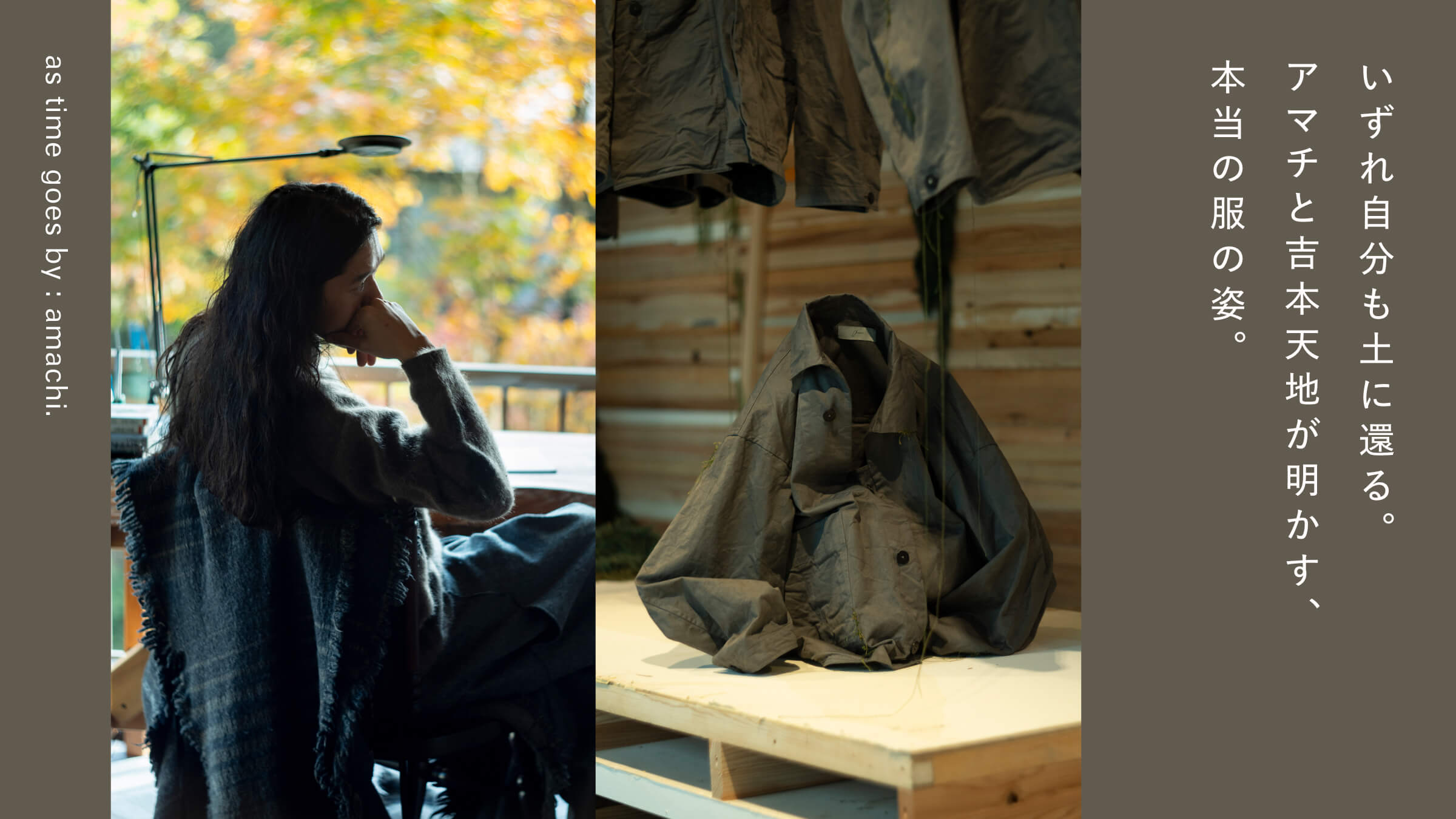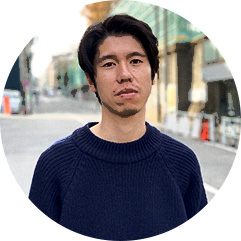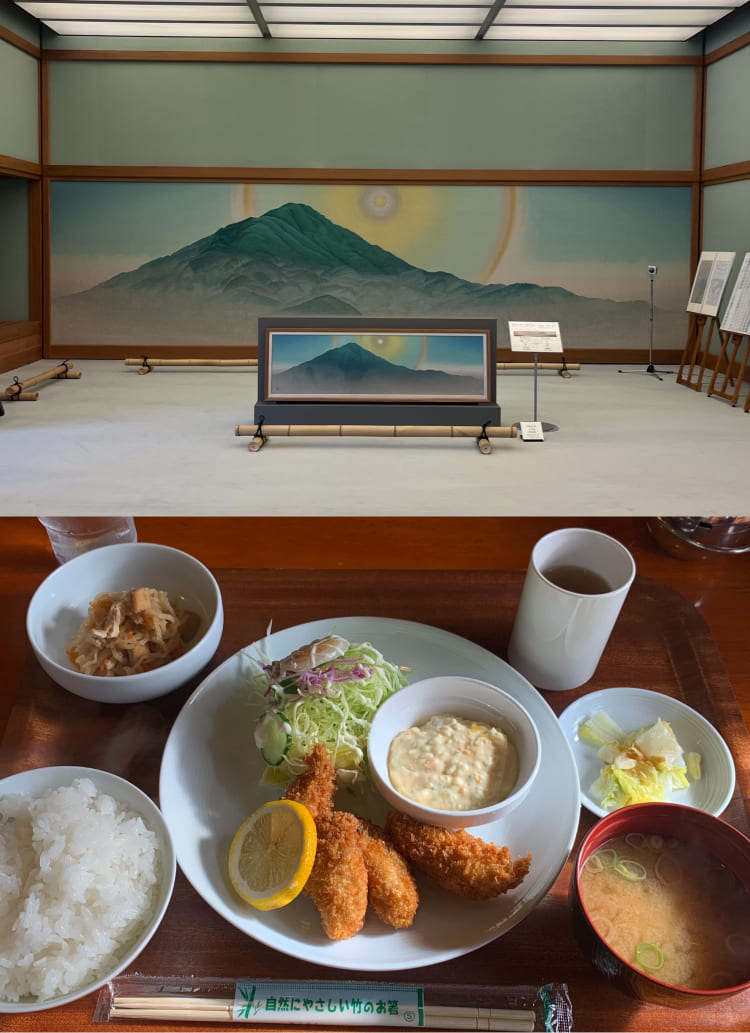Expanding areas and the shape of the future that we envision.
Yoshimoto is a fashion designer, but he is also an artist. From here, he will move to "21_21 DESIGN SIGHT" in Roppongi, Tokyo, where he will introduce the "Garbage Poo" exhibition, in which he participates as one of the collaborators in the planning and is also named as an artist.
The "Garbage Poo Exhibition." Although the title is extremely impactful, this is an attempt to update our stereotypes of garbage and emissions from multiple perspectives. The exhibition is directed by Taku Satoh, the director of the museum and a graphic designer, and Shinichi Takemura, a cultural anthropologist. They are flanked by a diverse group of artists who, under the keyword "pooploop" (circulation), interpret an inaccessible subject in a unique and positive way. The exhibition, which opened last September, has been attracting a great deal of attention and many visitors of all ages, as well as foreign visitors to Japan.

This exhibition takes a different angle on a theme that is often lumped together with sustainability and upcycling.
Yoshimoto's participation in the project was originally triggered by an offer from Sato. Their first encounter dates back to the "Studio Ghibli" exhibition held at the Aichi Prefectural Museum of Art in 2021. At that time, Sato supervised the planning and Yoshimoto was in charge of the space design.
And for the "Gomi Unchi" exhibition, Yoshimoto joined the planning team and worked with the team to come up with the exhibition structure and exhibiting artists.
The venue is composed of two main sections. The first is a space titled "Room of Fecal Wonders," where more than 700 types of artworks and materials are on display, surprising visitors. The number of exhibits is said to exceed 2,000 when each detailed exhibit is counted individually.

A wide variety of actual trash, emissions, recycled resources, and fossils are lined up.
To begin with, a "room of wonders" refers to a room where an aristocrat who collects curiosities shows his collection. It has existed as an exhibition style for a long time and is said to have been the prototype of the museum.
The theme of this exhibition is connected to all things with the keyword of circulation. We wanted to show here exactly what we learned during the planning stage, including the concept of circulation, which was the basis for the creation of the works by the participating artists. I was one of the originators of the "Fecal Wonders Room," and it took a lot of determination to express this, but we created it with Tomohiro Okazaki, the art director, at the center.
Also displayed here are Yoshimoto's personal items, including torso molds, sarcophagi, felt scraps, and cork bark.



Yoshimoto's personal belongings lined up in the "Room of Friggin' Wonders."
And spread out behind the "Room of Fecal Wonders" is the core space of the exhibition. Thirteen artists will participate in this space, including works that dare to reuse items normally treated as garbage or emissions, and works that redefine the concept of circulation and values.
In this space, Yoshimoto exhibited three works from the "sign" series. The most eye-catching piece is "Kioto - Covering," a huge wooden fixture with knit modules arranged around it to resemble moss.

Coexisting with the fixtures are Yoshimoto's work and "cycling -go at-" by sculptor Hiroki Ihara. This is made of goat dung.
In this series, I am exploring the boundary between natural and man-made objects. I sometimes use this fluctuation as a theme for making clothes, and "A sign - a cover" is an installation work that evokes the image of a building that is gradually eroding and decomposing. The work was created on site, using hand-knitted knit modules, which were added during the installation, and colors were mixed. The modules are placed on topographical fixtures presented by Tomoki Ohno of "Domino Architects," who was in charge of the exhibition's spatial composition. I think it is similar to the feeling of creating a garden, where the work is created while reading the works of others in the entire exhibition space, like manipulating the environment.
The woolly knitwear is made of a special cotton yarn and knitted by artisans in a variety of colors and patterns.

Knit modules come in four sizes and are configured in combinations.

Yoshimoto adjusting his work at the venue.
In fact, it is interesting to note that these knit modules are placed not only in the huge fixtures, but also in various places in the venue, increasing, decreasing, and moving during the exhibition period.
The most conspicuous pieces are the ones on the fixtures, but I think the main body of the work is the ones in the corners of the exhibition hall. I sometimes come to the venue to work on the pieces, thinking about where they might actually grow. I imagine it permeating the entire venue."


The "sign - cover" is placed in various places as if to invade the building.
The second work is "Signs - Traces". The second piece is "Signs - Traces. This is a jacket hanging on a fixture made by combining antiques collected by Yoshimoto. This is from "Collection 000" introduced earlier. It is dyed in a natural process using pure natural dyeing, so the color changes when it is exposed to natural light, and its expression changes as it is worn and taken off by people. This piece is also a uniform for the staff and will be worn by them during the exhibition.

The neatly lined up form is as if people are lining up in a row.
When I looked at the circulation in my field, I thought about making clothes from recycled materials, but I realized that there is a different kind of circulation, not just from a material point of view. People think that clothes are most valuable when they are new and gradually lose value, but I feel that this idea itself needs to be changed. The idea is that the color changes, that the first state is not necessarily the best, and that its value also changes. Change is also a cycle of value, and this is such a work of art."

Threads coming from the seam of a garment. The "sign - cover" invades not only the building, but also the "sign - trace".

Once the dye is in the fabric, the jacket becomes firm enough to stand on its own.
In fact, Yoshimoto will be in charge of a related program to this exhibition, which will be held on January 18 (Sat.). The program is "Records of Phenomena," a live performance in which Yoshimoto will dye Amachi's clothes on the spot using dead branches and fallen leaves from the trees in the museum's courtyard, and is related to his work "Signs - Traces. Visitors are also invited to bring their own Amachi clothes to be dyed, so if you would like to experience this, please join the event.


The light-like, shadow-like pattern is a realistic camouflage pattern.
And the last work, "Presence - Presence" in the dimly lit room behind the gallery. Jackets, pants, and other garment-like objects are made of thick industrial felt fabric. It is a mysterious work that can be described as either a soft sculpture or a hard garment. The figure of the absent owner is somewhat like a shell.
When I thought about the cycle, I recalled that if I followed the process of decomposition, I myself would eventually return to the soil. Clothes are originally meant to be worn by people, and we can feel the presence of someone in them, but I created the work as if that person were no longer there."

The patterns are taken from the Fall/Winter 2024 collection pieces and sculpted.

The felt material is compressed fallen cotton.
Yoshimoto has long held the view that the smallest unit of space is a garment, and conversely, as it grows larger, it develops into a room or building.
Clothing has a symbolic meaning to the outside world, but in my mind, it is the first environment. It is something in between to connect people to the outside, and the same is true of buildings.

There are a total of five works in the "Presence.
Installation, space design, and interior design between clothes and space. Yoshimoto's vision is now gradually expanding from fashion to something much larger than clothes.
Including this exhibition, I have many aspects of my work that exist individually and are not yet connected to each other. When they are connected, they will complement and deepen each other. In the future, I think it will be necessary to have a space where all of these things can be shown simultaneously. The good thing about brands is their social nature, which makes them a community or hub that can incorporate a variety of things. That is why I wanted to become a fashion designer.
For Yoshimoto, now is the middle ground. He is looking for a place where he feels comfortable.
"It's also something I keep thinking about, which land I will ultimately commit myself to. The poet Gary Snyder, "A Sense of Place" and tells us that it is important which land we relate to as we relate to others in our lives. He also calls it resettlement. I think that inevitably equates to having a space that is open to us and where we can express ourselves."

Gary Snyder's book is at Yoshimoto's studio.









